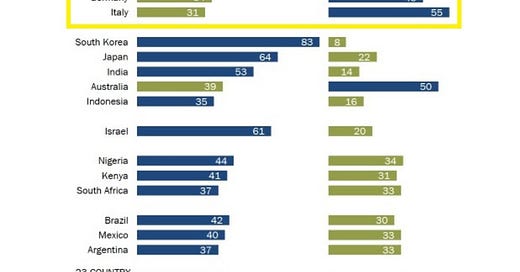Is Europe Plan B?
US stocks ended higher on Wednesday as investors weighed the Federal Reserve’s decision to hold interest rates steady and monitored developments in US-China trade tensions.
The S&P 500 added 0.4%, while the Nasdaq 100 rose 0.3%, while the Dow Jones gained 297 points.
Powell emphasised that uncertainty remains high and the Fed is in no rush to cut rates without clearer economic data.
Hopes for a breakthrough in upcoming US-China trade talks remained low, with President Trump stating he would not ease tariffs ahead of negotiations set for this weekend in Switzerland.
Nvidia rose 2.4% on reports of possible easing in chip trade rules.
We heard from the Fed - the market had already moved out expectations for a resumption of the easing cycle from June to July.
So, despite a PCE number from April that showed no inflation (zero monthly change), and is nearing its 2% goal, and despite a negative GDP reading for Q1, the Fed is standing pat with a Fed Funds rate 200 basis points above the rate of inflation - an historically tight policy stance.
Now, let's follow up on our discussion from yesterday.
We talked about the Trump administration's strategic manoeuvring to reduce reliance on China, to reduce China's negotiating leverage, and to coordinate with global trading partners to isolate China.
A significant threat to that strategy is Europe.
Just prior to the Trump 90-day pause on tariff escalations, Europe publicly announced that it had scheduled retaliatory tariffs against the U.S. We now have reports that the European Commission is planning to hit back with 100 billion euros of tariffs on U.S. goods IF trade negotiations fail.
As we’ve discussed, the Trump escalate-to-de-escalate plan is about drawing the rest of the world back into alignment with the U.S., using the U.S. consumer as leverage.
It doesn't seem to be working with Europe. Why? Probably because of this ...
As you can see in this PEW Survey, China has gained significant influence over Europe, largely stemming from its role in bailouts following the sovereign debt crisis in Europe a little more than a decade ago.
From 2010 to 2012, Europe was in the depths of a sovereign debt crisis. The debt dominos were lined up for default and ready to fall, which would have unravelled the European Monetary Union. It would have been game over for the euro.
It didn't happen because the world stepped in to save it, with a coordinated policy response from major central banks (the ECB, the Fed, the BOE and the BOJ). And China played a large role. They came in as buyers of euros, and European sovereign debt and state-owned assets (like Greek seaports).
What came with China's help? Economic coercion - they bought plenty of influence over European politicians.
So restoring U.S. influence within Europe hasn't worked. The Trump efforts to end the Ukraine-Russia war have been met with pushback from Europe. They've responded with the 800 billion euro plan to "re-arm" Europe, in what seems to be an effort to support a continuation of the war.
The trillion-dollar question is, who will fund it? Well, who's looking for a new market to direct its excess manufacturing capacity toward while also supplying the cheap credit to buy their stuff?
China.
As we discussed in my note early last month (here), with the U.S. looking to end the multi-decade wealth transfer to China, China may have a 'plan B' in Europe. Would the European Commission take the invitation to partake in China's capacity dumping, credit fuelling, and industry gutting economic partnership?
We may find out in the coming months.
Global Trend Report: The primary objective is to identify which asset classes and sectors are exhibiting potentially unsustainable behaviour and assess the extent of their crash risks, regime shift potential, and broader systemic vulnerabilities.
Commodity Chartbook: This document aims to reduce the opportunity and very real information costs of maintaining situational awareness within the liquid commodity universe.
Daily Dashboard: Summarising trends and inflection points from 450 systemic assets and about 850 single stocks, with scenarios of future price developments.









